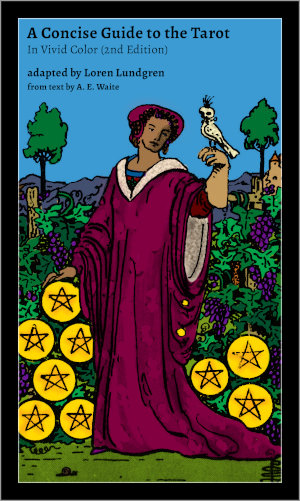Tarot Reading home family good; 31101955
Reading Performed 02/06/2013 at 9:28 AM
Click or scroll down for the meaning of each position and the interpretation of its card.
Visual Layout
The Meanings of these Tarot Cards
This Covers You
This card gives the influence which is affecting the person or matter of inquiry generally, the atmosphere of it in which the other currents work.
This Crosses You
It shows the nature of the obstacles in the matter. If it is a favourable card, the opposing forces will not be serious, or it may indicate that something good in itself will not be productive of good in the particular connexion.
The Fool from the Marseilles Pattern Tarot Deck
A. E. Waite's Secondary Meanings
The Fool, Mate, or Unwise Man. Court de Gebelin places it at the head of the whole series as the zero or negative which is presupposed by numeration, and as this is a simpler so also it is a better arrangement. It has been abandoned because in later times the cards have been attributed to the letters of the Hebrew alphabet, and there has been apparently some difficulty about allocating the zero symbol satisfactorily in a sequence of letters all of which signify numbers. In the present reference of the card to the letter Shin, which corresponds to 200, the difficulty or the unreason remains. The truth is that the real arrangement of the cards has never transpired. The Fool carries a wallet; he is looking over his shoulder and does not know that he is on the brink of a precipice; but a dog or other animal--some call it a tiger--is attacking him from behind, and he is hurried to his destruction unawares. Etteilla has given a justifiable variation of this card--as generally understood--in the form of a court jester, with cap, bells and motley garb. The other descriptions say that the wallet contains the bearer's follies and vices, which seems bourgeois and arbitrary.
This Crowns You
It represents (a) the Querent €™s aim or ideal in the matter; (b) the best that can be achieved under the circumstances, but that which has not yet been made actual.
This is Beneath You
It shows the foundation or basis of the matter, that which has already passed into actuality and which the Significator has made his own.
This is Behind You
It gives the influence that is just passed, or is now passing away.
The Star from the Marseilles Pattern Tarot Deck
A. E. Waite's Secondary Meanings
The Star, Dog-Star, or Sirius, also called fantastically the Star of the Magi. Grouped about it are seven minor luminaries, and beneath it is a naked female figure, with her left knee upon the earth and her right foot upon the water. She is in the act of pouring fluids from two vessels. A bird is perched on a tree near her; for this a butterfly on a rose has been substituted in some later cards. So also the Star has been called that of Hope. This is one of the cards which Court de Gebelin describes as wholly Egyptian-that is to say, in his own reverie.
This is Before You
It shows the influence that is coming into action and will operate in the near future.
Your Self
Signifies the person or thing about which the question has been asked, and shows its position or attitude in the circumstances.
The Papess from the Marseilles Pattern Tarot Deck
A. E. Waite's Secondary Meanings
The High Priestess, the Pope Joan, or Female Pontiff; early expositors have sought to term this card the Mother, or Pope's Wife, which is opposed to the symbolism. It is sometimes held to represent the Divine Law and the Gnosis, in which case the Priestess corresponds to the idea of the Shekinah. She is the Secret Tradition and the higher sense of the instituted Mysteries.
Your House
Your environment and the tendencies at work therein which have an effect on the matter €”for instance, your position in life, the influence of immediate friends, and so forth.
Your Hopes and Fears
The Chariot from the Marseilles Pattern Tarot Deck
A. E. Waite's Secondary Meanings
The Chariot. This is represented in some extant codices as being drawn by two sphinxes, and the device is in consonance with the symbolism, but it must not be supposed that such was its original form; the variation was invented to support a particular historical hypothesis. In the eighteenth century white horses were yoked to the car. As regards its usual name, the lesser stands for the greater; it is really the King in his triumph, typifying, however, the victory which creates kingship as its natural consequence and not the vested royalty of the fourth card. M. Court de Gebelin said that it was Osiris Triumphing, the conquering sun in spring-time having vanquished the obstacles of winter. We know now that Osiris rising from the dead is not represented by such obvious symbolism. Other animals than horses have also been used to draw the currus triumphalis, as, for example, a lion and a leopard.






















